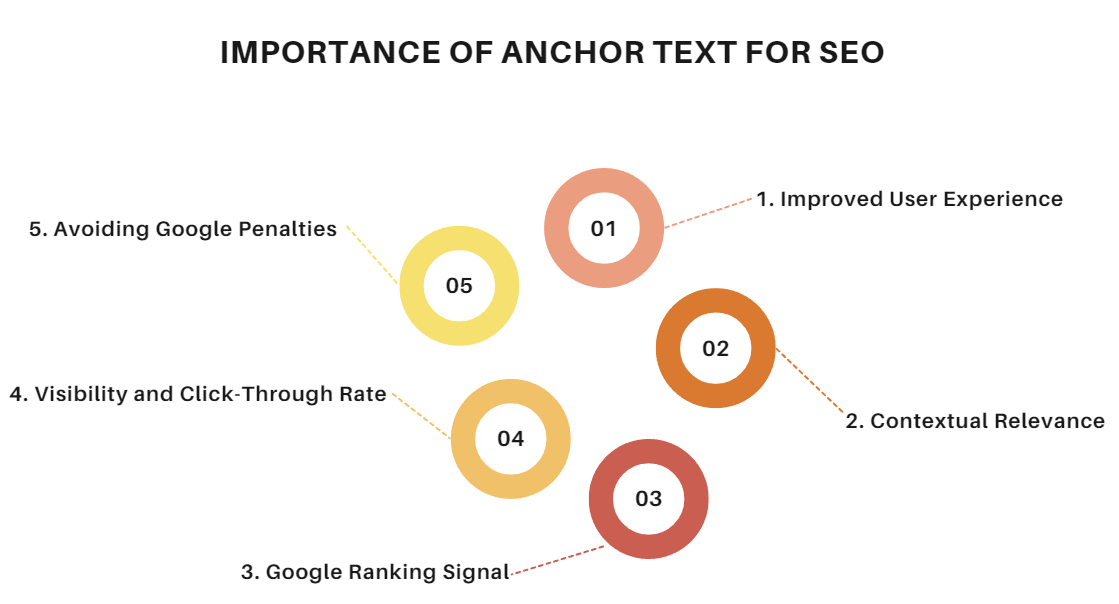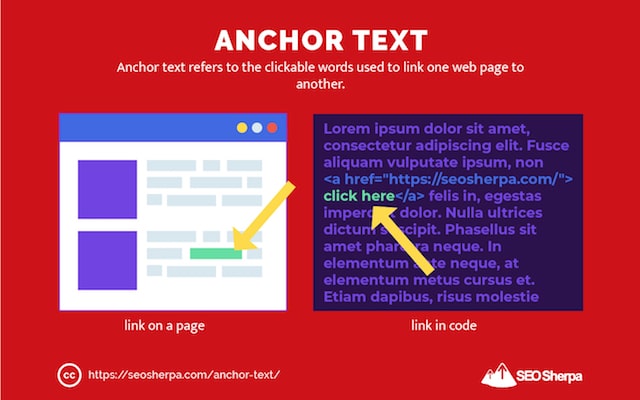Unlock the secrets to maximizing your website’s SEO potential with expert tips on optimizing anchor text. Boost your rankings today!

Image courtesy of via DALL-E 3
Table of Contents
- Introduction: What is Anchor Text?
- Types of Anchor Text
- Importance of Optimizing Anchor Text
- Best Practices for Optimizing Anchor Text
- Common Mistakes to Avoid
- Tools to Help with Anchor Text Optimization
- Real-Life Examples of Effective Anchor Text
- Conclusion: Summary of Key Points
- Frequently Asked Questions (FAQs)
Introduction: What is Anchor Text?
Anchor text is like the secret code that unlocks the magic of the internet. It’s a special word or phrase that you can click on to take you to another website or webpage. Anchor text is super important because it helps search engines like Google understand what a webpage is about and how it’s connected to other pages. This makes it a crucial part of something called SEO, which helps websites show up higher in search results.
Anchor Text Basics
Let’s break it down with an easy example. Imagine you’re reading a blog post about cute puppies, and you see a highlighted word that says “adorable puppies.” When you click on that highlighted text, it takes you to a website all about fluffy little dogs. That highlighted “adorable puppies” is the anchor text. It’s like a signpost guiding you to more puppy-filled goodness!
Anchor text is important because it’s like a keyword for the web link. Just like keywords help you find information in a book, anchor text helps search engines find the right web pages for your searches. So, next time you click on a link, remember that the anchor text is the behind-the-scenes hero that makes it all happen!
Types of Anchor Text
Anchor text comes in different forms, each serving a unique purpose when used in a hyperlink. Let’s explore the various types of anchor texts and how they are utilized in web linking.
Exact Match Anchor Text
An exact match anchor text is when the text of the anchor precisely matches the keyword or phrase that the hyperlink is pointing to. For example, if a website is about healthy eating and the anchor text says “healthy eating tips,” that would be an exact match.
Partial Match Anchor Text
Partial match anchor texts contain a variation of the target keyword or phrase. Instead of using the exact words, a related term is incorporated to maintain relevance. Using the earlier example, a partial match could be “tips for a healthy diet.”
Branded Anchor Text
Branded anchor texts feature the name of a brand or company as the clickable text. For instance, if linking to an article on Nike’s latest shoes, the anchor text might say “Check out Nike’s new collection.”
Naked URLs
Naked URLs are anchor texts that simply display the URL of the website without any specific keywords or descriptions. This type of anchor text is straightforward and direct, like “www.example.com”. It is often used when the URL itself is descriptive enough.
Generic Anchor Text
Generic anchor texts are non-descriptive, using general phrases like “click here,” “learn more,” or “visit this link.” While not as informative as other types, they can still be useful in certain contexts where the content surrounding the hyperlink provides enough context.
Importance of Optimizing Anchor Text
Optimizing anchor text is crucial for both search engines and users. When you use the right anchor text, it helps search engines understand what your webpage is about and can improve your search engine rankings. Additionally, optimized anchor text can enhance user experience by providing clear and descriptive links that guide users to relevant content quickly and efficiently.

Image courtesy of neilpatel.com via Google Images
Better Search Engine Rankings
When you optimize your anchor text with relevant keywords, search engines like Google can better interpret the context of your webpage. This can lead to higher rankings in search results, making it easier for people to find your content when they search for related topics. By using anchor text strategically, you can improve the visibility of your website and attract more organic traffic.
Improved User Experience
Clear and descriptive anchor text not only benefits search engines but also enhances the user experience. When users encounter optimized anchor text, they can easily understand where a link will lead them before clicking on it. This transparency helps users navigate websites with ease, find the information they are looking for, and ultimately have a more satisfying browsing experience.
Best Practices for Optimizing Anchor Text
When it comes to optimizing anchor text for your website, there are a few key best practices to keep in mind. By following these guidelines, you can help improve your SEO and enhance the user experience on your site.
Keep It Relevant
One of the most important things to remember when creating anchor text is to keep it relevant. The anchor text should accurately reflect the content of the linked page. For example, if your anchor text is “best chocolate chip cookie recipe,” make sure the linked page actually contains that recipe. This helps both users and search engines understand what to expect when they click on the link.
Make It Descriptive
Descriptive anchor text provides valuable context for both users and search engines. Instead of using generic phrases like “click here” or “read more,” try to use specific keywords that accurately describe the content of the linked page. For example, instead of saying “click here for more information,” you could say “learn more about our products.” This gives users a better idea of what they will find when they click on the link.
Avoid Over-Optimization
While it’s essential to use relevant and descriptive anchor text, it’s also crucial to avoid over-optimizing. This means not using the same anchor text too many times within your content. Overuse of exact match anchor text can appear spammy to both users and search engines, potentially harming your SEO efforts. Instead, vary your anchor text and use a mix of relevant keywords to create a natural and user-friendly linking strategy.
Common Mistakes to Avoid
In the world of web linking and SEO, it’s crucial to understand not just what to do, but also what NOT to do. Here are some common mistakes to avoid when it comes to optimizing anchor text:

Image courtesy of neilpatel.com via Google Images
Keyword Stuffing
One common mistake many people make is keyword stuffing. This happens when someone uses the same keyword excessively in their anchor text in an attempt to manipulate search engine rankings. However, search engines are smart enough to recognize this tactic and may penalize your website for it. It’s essential to use keywords naturally and in a way that adds value to the content.
Using Irrelevant Links
Another mistake to avoid is using irrelevant links. When your anchor text doesn’t match the content of the linked page, it can confuse both search engines and users. Make sure your anchor text accurately reflects the destination of the link to provide a better user experience and improve SEO.
Overusing the Same Anchor Text
Overusing the same anchor text can also be detrimental to your SEO efforts. When search engines see the same anchor text repeated multiple times, it may appear as though you are trying to manipulate rankings rather than providing valuable content. Vary your anchor text to make it more natural and engaging for both users and search engines.
Tools to Help with Anchor Text Optimization
When it comes to optimizing anchor text for better SEO performance, there are various tools and software available that can assist you in analyzing and improving your anchor text strategy. These tools can help you understand how your anchor texts are performing, identify areas for optimization, and ultimately boost your website’s visibility in search engine results. Let’s take a look at some of the essential tools you can utilize:
SEO Analysis Tools
SEO analysis tools like SEMrush, Ahrefs, and Moz can provide valuable insights into your anchor text strategy. These tools allow you to conduct in-depth analyses of your anchor texts, including the distribution of different types of anchor text, the relevance of your anchor texts to the linked content, and the overall impact on your SEO efforts. By using these tools, you can identify areas that need improvement and make informed decisions to enhance your anchor text optimization.
Anchor Text Audit Tools
Anchor text audit tools are specifically designed to help you assess the quality and effectiveness of your anchor texts. Tools like Screaming Frog and Linkio can crawl through your website and identify any issues with your anchor text usage, such as over-optimization, irrelevant anchor texts, or broken links. These tools can also provide recommendations on how to optimize your anchor texts for better SEO performance and user experience. By conducting regular audits using these tools, you can ensure that your anchor text strategy remains effective and compliant with best practices.
Real-Life Examples of Effective Anchor Text
Let’s take a look at some real-life examples of websites that have effectively utilized anchor text to enhance their SEO and user experience.

Image courtesy of seosherpa.com via Google Images
One prime example is the website “Healthy Eats Daily,” which offers nutritious recipes and meal planning tips. On their homepage, you’ll find anchor text such as “easy breakfast recipes” linking to a blog post with delicious breakfast ideas. This descriptive and relevant anchor text helps users navigate the site easily and improves their overall experience.
Another successful website, “Adventure Gear Hub,” utilizes anchor text effectively by incorporating phrases like “top hiking essentials” in their product descriptions. These phrases act as anchor text linking to specific product pages, guiding users directly to the items they might be interested in. This not only enhances user experience but also helps search engines understand the content and context of the linked pages.
By analyzing these examples, it’s clear that well-crafted anchor text plays a crucial role in attracting organic traffic, improving search engine rankings, and ultimately providing a better user experience. When anchor text is used strategically and thoughtfully, it can significantly boost a website’s visibility and engagement.
Conclusion: Summary of Key Points
In this article, we delved into the world of anchor text and explored the best practices and strategies for optimizing it. Let’s recap the key points discussed:
Anchor Text Basics
Anchor text is the clickable text in a hyperlink that directs users to another webpage. It plays a crucial role in SEO by providing context to search engines about the linked content.
Types of Anchor Text
We discussed various types of anchor texts, including exact match, partial match, branded, naked URLs, and generic anchor text. Each type serves a different purpose in linking strategies.
Importance of Optimizing Anchor Text
Optimizing anchor text is vital for improving search engine rankings and enhancing user experience. Clear and relevant anchor text helps users navigate the web more efficiently.
Best Practices for Optimizing Anchor Text
It is crucial to keep anchor text relevant to the linked content, make it descriptive for better understanding, and avoid over-optimization by using a diverse range of anchor texts.
Common Mistakes to Avoid
Avoid keyword stuffing, using irrelevant links, and overusing the same anchor text to prevent negative impacts on SEO and user experience.
Tools to Help with Anchor Text Optimization
Utilize SEO analysis tools and anchor text audit tools to analyze and optimize anchor texts effectively.
Real-Life Examples of Effective Anchor Text
We showcased successful websites using anchor text effectively to provide inspiration and insights into best practices.
By following these guidelines and understanding the importance of anchor text optimization, you can enhance your website’s visibility and user experience. Remember, anchor text is a powerful tool that can significantly impact your SEO efforts.
Want to turn these SEO insights into real results? Seorocket is an all-in-one AI SEO solution that uses the power of AI to analyze your competition and craft high-ranking content.
Seorocket offers a suite of powerful tools, including a Keyword Researcher to find the most profitable keywords, an AI Writer to generate unique and Google-friendly content, and an Automatic Publisher to schedule and publish your content directly to your website. Plus, you’ll get real-time performance tracking so you can see exactly what’s working and make adjustments as needed.
Stop just reading about SEO – take action with Seorocket and skyrocket your search rankings today. Sign up for a free trial and see the difference Seorocket can make for your website!
Frequently Asked Questions (FAQs)
Why is Anchor Text Important?
Anchor text is crucial because it tells both users and search engines what to expect when they click on a hyperlink. For users, clear and descriptive anchor text helps them understand where the link will take them, improving their overall experience on a website. From an SEO perspective, search engines use anchor text to determine the relevance and context of the linked page, which can impact the web page’s ranking in search results.
Can I Use the Same Anchor Text Multiple Times?
While it is possible to use the same anchor text multiple times, it is essential to do so strategically. Overusing the same anchor text can appear unnatural to search engines and might be considered as keyword stuffing, which can harm your SEO efforts. It is generally recommended to vary your anchor text by using different variations or related keywords to ensure a diverse and organic link profile.







